
This week was a week of highs and lows.
SpaceX launched the biggest commercial satellite ever but the last ever Antares 230 also launched.
Plus a new radar satellite for Singapore and a bunch of Starlink and Chinese launches.
First up is that large comm sat. On July 28th, SpaceX launched Jupiter 3 (aka Echostar 24) on a Falcon Heavy into a high perigee geostationary transfer orbit. The launch was delayed several times, first for weather and then an abort 1 minute before launch. The abort was determined to come from a faulty valve responsible for pressurizing the liquid oxygen tank on one of the rocket’s side boosters. It was replaced and the launch was rescheduled.
Jupiter 3 is the largest communications satellite ever launched, weighing in a little over 9 metric tons. To get it to its high orbit the Falcon Heavy’s core stage was expended, as has become routine for Falcon Heavy launches.
It’s not impossible to recover it like they do the side boosters, but most Falcon Heavy launches that could see the center core recovered would probably be better served by an expendable Falcon 9 instead since that rocket is much cheaper.
The side boosters were originally slated to be recovered downrange on both of SpaceX’s Atlantic based drone ships, but the mission profile was changed to return to launch site landings to accommodate SpaceX’s frenetic launch schedule.
The barges were instead used to catch the first stages of 2 Falcon 9 based Starlink launches the week before.
The land landings were successful, as were the three burns of the second stage that delivered the satellite into its high perigee geostationary transfer orbit three and a half hours after launch. The satellite’s owner, Hughes, made contact with the satellite a few minutes later.
The next launch since the last show was DS-SAR on an Indian PSLV rocket on July 29th.
DS-SAR is a radar satellite belonging to the Singapore Government. It will also be used by the commercial company ST Engineering. The radar instrument was made by an Israeli company. The PSLV also carried six small satellites, which were developed by different universities in Singapore.
On August 1st, the final Antares 230+ sent the Cygnus NG 19 Laurel Clark to the ISS. It carried 3,785 kilograms of payload, most of which were supplies for use inside the station, along with a small number of components that will be used outside the ISS.
You can read about some of the experiments sent up on Cygnus at the link in our Show Notes.
This is the last Antares 230 because deliveries of the rocket’s engines were canceled by Russian authorities after Russia was sanctioned due to their unprovoked invasion of Ukraine.
Besides the rocket’s engines no longer being unavailable, the factory in Ukraine where the first stage tank for the Antares was manufactured was also destroyed by the Russians in 2022.
Northrop Grumman has a plan to build a new first stage for the Antares using a slightly modified first stage made by another company, Firefly, which is being developed for Firefly’s Beta rocket.
Until it’s ready, Cygnus will be launched on Falcon 9 rockets, putting the USA in the uncomfortable position of having its only active crew spacecraft and both active cargo spacecraft dependent on the Falcon 9 rocket until mid 2025.
Also since the last show were five launches by China that we don’t know much about and three more batches of Starlink satellites.
Lower third: Space Stats up to August 2nd, 2023
Image: graph
We keep track of orbital launches by launch site, also called spaceport. According to RocketLaunch.live, so far this year…
The USA has had 57 launches;
China: 31;
India: 6;
Kazakhstan: 5;
New Zealand and Russia each have had 4;
French Guiana and Japan each have had 2;
And Israel, North Korea, South Korea and the United Kingdom each have had 1.
Of these 115 launches, there have been 5 failures, reminding us space is hard.
